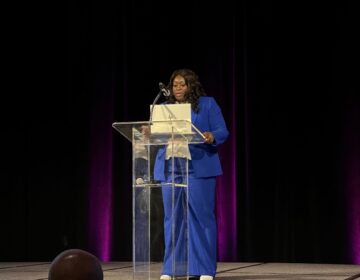Pedestrian safety in Delaware a ‘grave concern’

Education campaign from DOHS.
Delaware is addressing the rise in pedestrian fatalities – hoping awareness will change behavior.
Delaware is facing a rise in pedestrian fatalities throughout the state—and with two months left in the year, the numbers could well surpass last year’s. According to the Delaware Office of Highway Safety (DOHS), pedestrian fatalities make for about 30 percent of all road fatalities combined.
Data received by the DOHS also shows that most of these incidents occurred when pedestrians weren’t using a crosswalk, and a large percentage of the pedestrians were intoxicated.
Now the state hopes new education initiatives, along with the governor’s call to action for an advisory council on pedestrian safety, will prevent numbers from increasing next year.
“You put all those numbers together and we do have a grave concern about pedestrian safety across our state,” said Director of the DOHS, Jana Simpler.
So far in 2015 there have been 29 fatalities—just squeezing past 2014’s total of 27. Simpler said there could be more in the remaining couple months because pedestrian fatalities occur more frequently later in the year. In addition, there have been 252 non-fatal pedestrian incidents this year.
According to a pedestrian safety report by Smart Growth America, Delaware had more pedestrian fatalities per 100,000 people than the national average between 2003 and 2010.
These numbers could decline with awareness, such as using a crosswalk, wearing bright clothing and getting a ride home when intoxicated, Simpler said.
She said she hopes to decrease those numbers through an enforcement and education initiative that rolls out in November. The initiative involves the help of law enforcement and an advertising campaign throughout the state.
The campaign will start just a few weeks after Gov. Jack Markell, D-Delaware, announced an executive order to create an Advisory Council on Walkability and Pedestrian Awareness to make recommendations on how to address pedestrian safety issues.
“If we note the responsibility of the state to address the number of pedestrian fatalities…I think motorists and pedestrians have to have a better understanding of Delaware laws,” Markell said.
“The council is going to provide important input on how we can better inform pedestrians and, in addition, we want to improve walkability in the state because it’s better for quality of life.”
Between January 2014 and Oct. 21 2015 New Castle County had 31 fatalities, making it the county with the most pedestrian fatalities, according to DOHS.
Across Delaware, during that same time, 42 pedestrians killed by a car were not in a crosswalk during a crash—only four victims were and nine are unknown.
In addition, 24 of the victims were under the influence of drugs or alcohol—compared to four drivers found to be intoxicated.
Seven incidents are still pending, so the number of pedestrians under the influence could increase, Simpler said.
“Yes it’s a difficult issue to address, but we do talk to pedestrians about ensuring they’re not impaired walking home at night, crossing highways, and to find a safer avenue to get home,” she said.
Markell said part of what his council will do is discuss the educational component of prevention.
“Obviously when people make bad choices they put themselves in danger, so that is a reality. We have to do a better job making sure people don’t make those choices—but a lot of that comes down to personal decision making,” he said.
“There are things that could be done in terms of our education, and our intersections and the like, that we can improve.”
The report also finds that most incidents occurred in a 50 mile-per-hour area, which could be a factor because pedestrians aren’t able to judge how quickly a vehicle is approaching them, Simpler said.
The DOHS also reports that 58 percent of pedestrian fatalities during that period occurred between 9 p.m. and 5 a.m. The majority of accidents also occurred where there was no lighting at all.
In November and December the agency will work with law enforcement, who will participate in overnight enforcement and educate pedestrians.
Part of the education initiative includes distributing reflective materials, such as wristlets and flashlights. The DOHS will advertise at Concord Mall, and at bus shelters and inside buses. The agency also will install sidewalk decals to remind pedestrians to use cross walks and wear light colored or reflective clothes.
Much of the enforcement and education will take place in the areas of Routes 13 and 40 and Kirkwood Highway, because the majority of crashes occur in these areas, Simpler said.
The agency is also discussing pedestrian checkpoints to inform pedestrians how to adopt safer habits.
“Not only is it important to enforce the law, but tell the public we’re enforcing the law and inform them how to stay safe and stay within the confines of what the law says,” Simpler said. “That’s how we encourage the public to change their behavior.”
Markell is also asking the new advisory council, which consists of several state and city agencies, including DOHS, to revisit Delaware’s Statewide Pedestrian Action Plan, last updated in 2007. The council will report their findings and recommendations to encourage further improvements.
The council, which will begin meeting early next year, will discuss items like fixing gaps in pedestrian paths and sidewalks, designing crosswalks, sidewalks and pathways, reviewing traffic rules and developing strategies for education and awareness.
“We’ve been doing a lot, but there’s clearly more to do and that’s why I look forward to the recommendations,” Markell said.
“The long-term goal is to make Delaware more walkable, to improve pedestrian safety, because we want all parts of our state attractive places to live and work and having better pedestrian safety is a part of that.”
WHYY is your source for fact-based, in-depth journalism and information. As a nonprofit organization, we rely on financial support from readers like you. Please give today.





